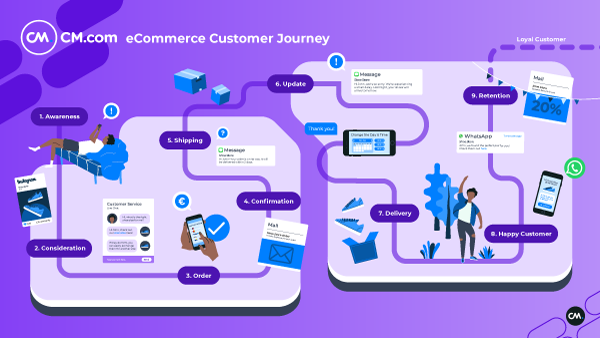- Personalization in eCommerce: why it matters more than ever…
- At the first contact
- During the initial order
- To using the right channels in real time
- And giving nudges to help things along
- … and how to do it: plan communication across silos
Take a simple mass-customized email to “Dear John”. Is it personalized? Yes. But is it effective? No – since merging FirstName or LastName into a messaging campaign is the absolute minimum any marketer should do.
And there’s a lot more to it than that.
True personalization goes beyond inserting the customer’s name. It starts with the first contact and grows as the relationship does. It means recognizing where your customer came from, what they did before, and seeing each customer touchpoint not as a separate event, but as part of an ongoing conversation over time.
Increasingly, it also means doing all this across different channels, presenting the same friendly face to the customer whether he/she responds with an email, WhatsApp message, or types into a Chat window somewhere. And in addition to all this, it means staying personal at scale, even when you have thousands of messages a day going out – making every customer feel like your only customer.
78% of consumers prefer and recommend a brand that provides personalized services.
That’s not easy. But it’s our philosophy here at CM.com. Seeing various datasets as part of the same whole, as a single seamless view of the customer whatever channel choices they make. Using software intelligence to make your human agents more effective, automating some tasks so they can apply their creativity elsewhere. And making sure different events stay part of the same conversation, giving your customers no reason to check out a competitor. (Let’s remember: failure is never more than a click away.)
Let’s look at why this matters and how this best-in-class eCommerce personalization works – fitted to the customer journey as you know it.

Personalization in eCommerce: why it matters more than ever…
At the first contact
Of course, personalization should be part of every marketer’s toolkit, from the most innovative eCommerce merchant to the most old-school family business. Nowadays, customers expect a personal touch. Especially in uncertain times, it is important to meet these expectations to prevent your customers going to competitors.
But in eCommerce, it’s perhaps even more vital. Because your customer is there on the web while doing business with you: one mismanaged interaction, one slow response, and it’s Hey Google! to search for alternatives.
Accenture says 91% of customers are more likely to buy when an ecommerce site remembers them.
Note: personalization isn’t something that only starts after the customer signs up for an account. It starts at the very first interaction – whether that’s through a web inquiry, a chatbot interaction, or a reach-out by mobile phone. Recognizing the customer as an individual – from the moment he lands on your website, to the awareness and consideration stages of the funnel – puts you ahead of the game, even before you know their name.

During the initial order
Understanding this lets you continue the interaction at another key touchpoint: that first order. If there’s a smooth pathway from awareness to that first “Buy” click, it improves the customer experience – because the customer will never feel you’re wasting their time.
Example? The “break” between a chatbot conversation (however successful) and adding an item to a shopping basket. In far too many businesses, these are two separate interactions – but they don’t have to be. Imagine the initial web chat ending with a purchase of the product in question, catching the buying journey within the conversation. That’s real personalization.
To using the right channels in real time
The next risky touchpoint – where that sense the retailer knows you can be lost – is order admin: the confirmation and shipping reminders. Most businesses send these by email, and they don’t always make use of valuable data points that can drive sales higher.
What if your shipping updates went out as part of the same WhatsApp conversation the customer started, keeping everything in one place? Or supply chain mishaps (the kind we’re all having these days) could be communicated in real-time by SMS rather than less-looked-at email, giving the customer instant satisfaction that you’re solving the issue? All are options – and savvy eCommerce sites are using them.

And giving nudges to help things along
After the first order’s gone out comes the real opportunity for eCommerce personalization: cross-selling and up-selling. That moment when a customer leaves your site with a full cart? Or looks at a product recommendation multiple times? Or looks at a previously purchased product … again?
All are potentially profitable, if you send the right communication at the right time. And these capabilities are no longer reserved for enterprise-scale retailers like Amazon. Adopting a cross-channel personalization mindset will help.
… and how to do it: plan communication across silos
Of course, if it were easy everyone would be doing it. So let’s look now at the one element eCommerce retailers really need for effective personalization: communication across departments.
There’s no way around it. If Marketing is hoarding your mailing list while Customer Service operates in a separate silo, your communications will look fuzzy and jumbled to the customer. A buying history won’t be recognized if they phone in; a discount earned from one channel may not be available in another; and a thousand other little disconnections that annoy the customer. And you don’t even want to think about the effect a “New customers only!” offer has on someone who’s been buying from you forever.
So how can you change it? To finish up, here are some methods we’ve explored at CM.com.
Multidisciplinary teams can help. People who can guide customers across the whole journey without a handoff, or who use their knowledge and awareness of how different departments interact to smooth over gaps in the customer experience, are very valuable people. And it’s also a very valuable mindset to adopt across your organization.
Build a single, comprehensive view of customers’ needs and behaviors, and share across all departments. Help Sales, Marketing, Service, and CX use this 'single version of the truth' as their basis for communications. Integrate customer data into all your tools.
Spend less time on loyalty, and more on connecting possible breakpoints where customers can lose interest. Customers continue buying from you if you make it easy for them, on the channels they prefer – not because they feel “loyal”.
Use chatbots in the right way. AI bots are now part of your customer service infrastructure, and they’re getting smarter all the time – able to help customers with common questions, point them to useful resources, and even slip in links to products you sell.
Think of channels as different parts of the same experience, not separate. The customer who always asks your chatbot about product information might never use chat at purchasing time. Always offer multiple channels and let the customer choose the ones they prefer.
And integrate, integrate, integrate! Of course, there are services that can help – like CM.com’s Mobile Marketing Cloud and Mobile Service Cloud. Combining these solutions will bring together multiple channels, campaigning, and management tools in the cloud.
Silo thinking is the barrier to real personalization. Solve this, and you’ll enable a whole new world of individually-tailored, multi-channel, joined-up customer experiences – helping you acquire and retain customers for the long term.

That’s true personalization. As you’ve seen, it’s a lot more than mailmerging customer names in your CRM. And this is where CM.com can help. Our cloud-based services let you campaign, communicate, and converse with customers across the many channels they use every day – with every interaction point and sales opportunity maximized for customer satisfaction and profitability.
